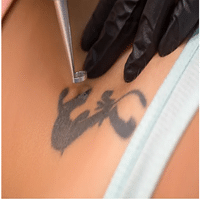Removing tattoos with laser techniques: technologies and treatment phases

Removing tattoos on your body means undergoing aesthetic medicine treatments to restore your skin to its natural state. In this short article, we want to delve into the merits of laser technologies and the sessions required to obtain a valid result.
What are the tattoo removal techniques?
Solutions to remove traces of ink in the epidermis have existed for several decades. Here we will dedicate ourselves in detail to the two currently most widespread laser techniques (Q-switched and Picosecond) but, for completeness, we want to list some alternative procedures.
- CO2 laser technique: ancestor of Q-switched and Picosecond lasers with limitations in terms of healing and final result.
- TES technique: innovative technology that works by stimulating an inflammatory reaction aimed at eliminating ink residues; all the consequences are not known.
- Dermabrasion: abrasion of the skin with chemical and mechanical solutions that can cause burns and discoloration; little used today.
- Surgical technique: surgical removal of the tattoo with grafting of a new layer of epidermis; very invasive and, therefore, obsolete technique.
What are the most common laser techniques and what advantages do they bring?
One of the most used laser technologies in dubai tattoo removal is, certainly, Q-switched. The logic of this treatment is to fragment the pigment via a laser beam tuned to different wavelengths. Once the sessions are finished, the cells of our body will assimilate the treated ink molecules. The evolution of Q-switched machines is the Picosecond ones. The operation is similar and the power delivered is similar, but the speed of the beam is 1000 times higher and, therefore, the treatment time is quicker. Furthermore, since the epidermis will be subjected to irradiation for a shorter time, the healing process is faster.
What is evaluated during the first dermatological visit?
Removing tattoos is a full-fledged aesthetic medicine procedure. Therefore, it is essential to follow precise clinical practice. The process begins with a dermatological visit aimed at analyzing the tattoo and the characteristics of the tissues. The type of ink used, its quality, the depth to which it is reached, the type of skin, any allergies, and the healing capacity are determining factors in defining the phases and tools used in the treatment. During this first check, you will also be informed about the risks and the approximate result that will be obtained in order to avoid disappointment after the fact.
How is laser tattoo treatment performed?
Tattoo removal procedures utilizing laser technology are usually quick and painless. It is possible to have discomfort, although it will be less intense and shorter than it was throughout the tattooing process. The number of sessions required is determined by the technique employed, the size of the region to be treated, and the specifics of the tattoo (kind of ink, depth, etc.). Typically, 4 to 10 sessions (spaced a few months apart) are required. To experience the greatest outcome of the procedure, you must obviously wait for the body to eliminate the ink. The duration varies between 12 and 18 months.
Are there any risks or negative effects of laser tattoo removal?
Yes, while laser tattoo removal is generally safe, there are potential side effects. There’s a possibility of temporary outcomes, such as redness, swelling, blistering, or variations in skin pigmentation. Scarring or infection, although uncommon, may also occur. It’s crucial to follow post-treatment care instructions and choose a qualified and experienced practitioner to minimize risks. During the initial dermatological visit, your specific skin type, allergies, and healing capacity will be assessed to tailor the treatment plan and minimize potential complications.
Final Words
Laser tattoo removal, with its prominent techniques like Q-switched and Picosecond lasers, offers an efficient path toward restoring skin to its natural state. The initial dermatological assessment plays a pivotal role in tailoring the treatment strategy. Understanding factors like ink type, skin quality, depth, and potential allergies ensures a personalized approach. While this procedure is generally safe, there are potential side effects such as temporary skin reactions. These risks are mitigated by adhering to post-treatment care and selecting experienced professionals. Patience is key as it can take between 12 to 18 months for the body to fully eliminate ink, but the treatment’s effectiveness, coupled with minimal discomfort, makes laser dubai tattoo removal a reliable option for those seeking tattoo removal.

